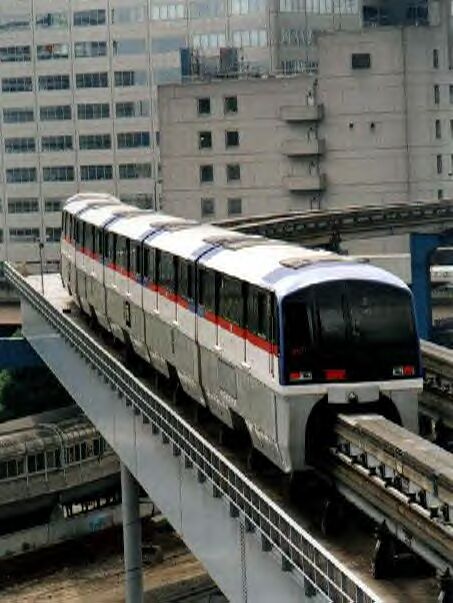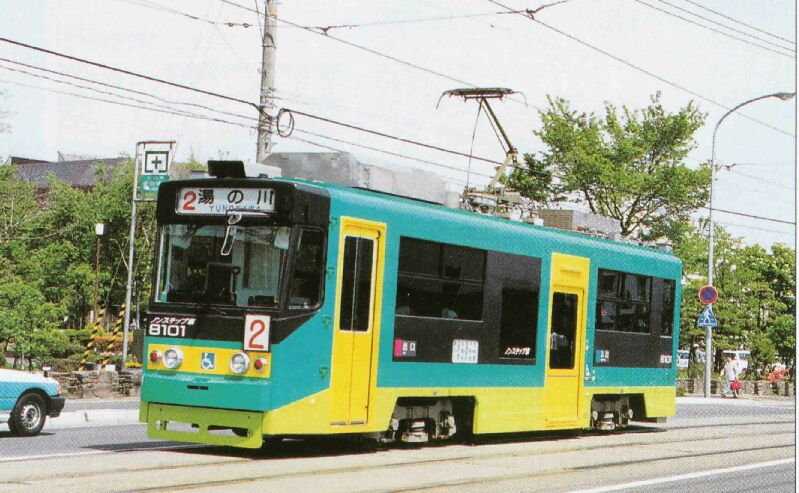Monorail advocates frequently make extravagant assertions about
the supposedly exceptional "profitability" of monorail systems,
particularly compared to light rail transit (LRT) and other standard
rail transit systems. Zealous monorail supporters have been
known to make claims such as "the only public transportation
systems in the world being run for profit are monorail systems."
This, it's argued, should be considered "evidence of superior
technology."
 On its website, for instance, the Monorail
Society claims that "No matter what the cost of building one is, monorail has the
best chance of all transit modes of turning a profit." To support this type of assertion,
the foremost evidence offered by monorail
advocates invariably comes from Japan - particularly the experience of Tokyo's
Haneda Airport monorail connector line (see photo). Thus the Monorail Society
assures us that "... monorail can turn a
profit once built. The Tokyo Monorail ... is operated by a private business and turns a profit each year. This
is unheard of with conventional rail or bus systems."
On its website, for instance, the Monorail
Society claims that "No matter what the cost of building one is, monorail has the
best chance of all transit modes of turning a profit." To support this type of assertion,
the foremost evidence offered by monorail
advocates invariably comes from Japan - particularly the experience of Tokyo's
Haneda Airport monorail connector line (see photo). Thus the Monorail Society
assures us that "... monorail can turn a
profit once built. The Tokyo Monorail ... is operated by a private business and turns a profit each year. This
is unheard of with conventional rail or bus systems."
[Source: Monorail Society website, http://www.monorails.org, March 2003]
Such assertions of the exclusive "profitability" of Japanese
monorails are refuted by real-world facts. it should be noted that,
particularly in Japan – where traffic volumes are high, transport by
automobile is less encouraged than in North America, and public
transport is encouraged through government policies – a number
of rail passenger modes, including LRT (light rail), report operating
profits.
This is solidly substantiated by reliable operating data. As
researched from Japanese government statistics and analyzed by
Leroy Demery, Jr., various Japanese rail transport operators
reported an operating profit (simple operating revenues less
operating expenses, without deducting any finance charges or
taxes) for the 2000 fiscal year.
[Source: Sûûji de miru tetsudôô 2001, Un-yu Keizai Kenkyûû Kikôô, Tôôkyôô, 2001 (annual
publication of rail transport statistics, compiled by Japanese Ministry of Land, infrastructure
and Transport, Railway Bureau)]
These "profitable" rail and guideway system operators are
grouped by type of system in the following listings:
Monorails and ICTS (intermediate Capacity) Lines
with Operating Surplus ("Profit"), Year 2000
- Kitakyushu Monorail
- Kobe New Transit Co. (ICTS "Portliner" and "Rokkoliner")
- Osaka Monorail
- Saitama New Urban Transport (ICTS "New Shuttle")
- Shonan Monorail
- Tokyo Monorail
- Tokyo municipal monorail (Ueno Park, 1999)
- Yokohama New Transit Co., Ltd. (ICTS "Kanazawa Seaside Line")
- Yurikamome (ICTS, Tokyo)
Streetcar/LRT Systems
with Operating Surplus ("Profit"), Year 2000
- Enoshima Electric Railway
- Hakodate municipal streetcar system
- Kagoshima municipal streetcar system
- Nagasaki Electric Railway Co., Ltd
- Okayama Electric Tramway Co., Ltd
- Tokyo municipal streetcar system
- Tokyu Corp. (suburban Tokyo)
- Toyama Railroad Co., Ltd (streetcar division, Toyama)
Subway Systems
with Operating Surplus ("Profit"), Year 2000
- Fukuoka subway
- Kobe subway
- Hokushin Express Electric Railway Co., Ltd. (private-sector extension of Kobe
subway)
- Nagoya subway
- Osaka subway
- North Osaka Express Electric Railway (third-sector extension of Osaka subway)
- Tokyo-Teito Rapid Transit Authority
- Toyo Rapid Railway (third-sector extension of Tokyo subway)
Major City Electric Railway Systems
with Operating Surplus ("Profit"), Year 2000
(Size descriptors refer to network size)
- Aichi Peripheral Railway (Nagoya, small)
- Eizan Electric Railway Co., Ltd. (Kyoto, small, LRT-like)
- Hakone Tozan Railway (Tokyo, small)
- Hankyu Corp. (Osaka, large)
- Hanshin Electric Railway Co., Ltd. (Osaka, small but considered one of the "big
15" companies)
- Hokuso Development Railway (Tokyo, small)
- izu-Hakone Railway (Tokyo, small)
- Keihan Electric Railway Co., Ltd. (Osaka, large)
- Keihin Electric Express Railway Co., Ltd. (Tokyo, large)
- Keio Electric Railway Co., Ltd. (Tokyo, large)
- Keisei Electric Railway Co., Ltd. (Tokyo, large)
- Kinki Nippon Railway Co., Ltd. (Osaka, very large)
- Kobe Electric Railway Co., Ltd. (Kobe , large)
- Mizuma Railway (Osaka, tiny, LRT-like)
- Nagoya Railroad Co., Ltd. (Nagoya, very large)
- Nankai Electric Railway Co., Ltd. (Osaka, large)
- Nishi-Nippon Railroad Co, Ltd (Fukuoka, large)
- Nose Electric Railway (Osaka, small)
- Odakyu Electric Railway Co., Ltd. (Tokyo, large)
- Sagami Railway Co., Ltd. (Yokohama, medium)
- San-yo Electric Railway Co., Ltd. (Kobe, large)
- Seibu Railway Co., Ltd. (Tokyo, large)
- Semboku Rapid Railway (Osaka, small)
- Shin-Keisei Electric Railway (Tokyo, small)
- Sobu Nagareyama Electric Railway (Tokyo, tiny, LRT-like)
- Tobu Railway Co., Ltd. (Tokyo, very large)
- Tokyu Corporation (Tokyo, large)
Provincial Electric Railway Systems
with Operating Surplus ("Profit"), Year 2000
- Enshu Railway (Hamamatsu, interurban LRT)
- Fukushima Transport (Fukushima, interurban LRT)
- Hokuetsu Express Co. (northeast of Nagano)
- iyo Railway Co., Ltd. (Matsuyama, interurban LRT)
- Shizuoka Railway Co., Ltd. (Shizuoka, small, interurban LRT)
- Toyohashi Railroad Co., Ltd. (Toyohashi, small, interurban LRT)
It should also be noted that the three private-sector successors to
JNR on Honshu – JR-East, JR-Central, and JR-West – also
reported operating profits.
 it may come as a surprise to North
American readers that such a sizable number of transit services in Japan – such
as the Hakodate streetcar system, pictured at left – are able to meet direct operating
costs from farebox revenues, and even to generate a surplus – a phenomenon certainly not limited to
monorail systems, as the data above underscores. Commenting
on these data, Leroy Demery notes that "Large operators earn
profits from extremely high peak-period volumes. Smaller
operators (monorails in particular, but streetcar systems as well)
manage to collect a much higher average fare per passenger than
US operators could, and therefore turn a profit despite
unimpressive (i.e., unimpressively high) unit operating costs ."
it may come as a surprise to North
American readers that such a sizable number of transit services in Japan – such
as the Hakodate streetcar system, pictured at left – are able to meet direct operating
costs from farebox revenues, and even to generate a surplus – a phenomenon certainly not limited to
monorail systems, as the data above underscores. Commenting
on these data, Leroy Demery notes that "Large operators earn
profits from extremely high peak-period volumes. Smaller
operators (monorails in particular, but streetcar systems as well)
manage to collect a much higher average fare per passenger than
US operators could, and therefore turn a profit despite
unimpressive (i.e., unimpressively high) unit operating costs ."
